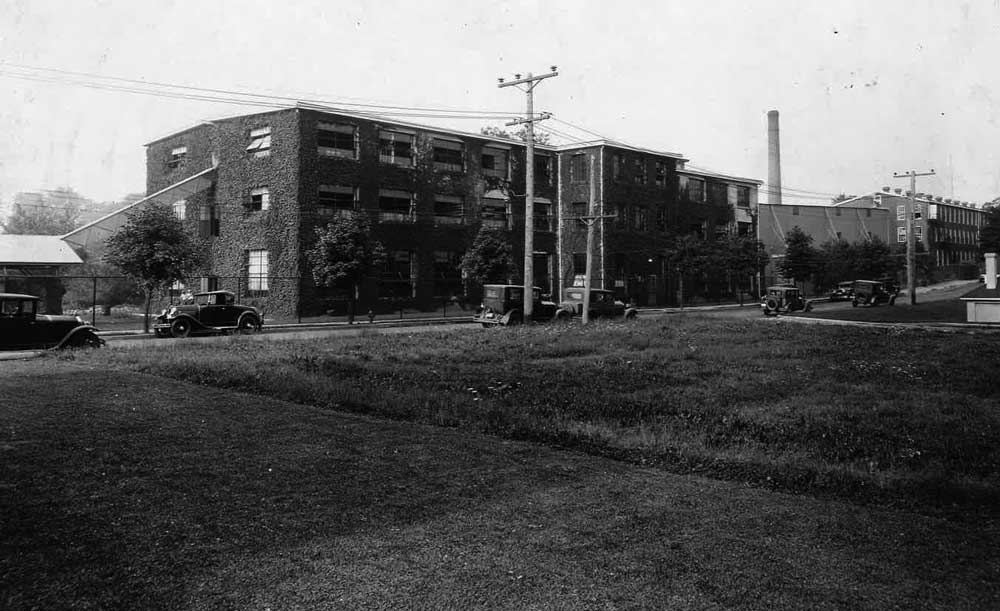
The Rug Mill in the 1920s.
Memories From My Youth
When I was young (the 1950s and 1960s), nearly every Hightstown-East Windsor area resident had a family member who either worked at or had worked at the Hightstown Smyrna Rug Factory, aka Hightstown Rug Company more commonly known as, “The Ruggie.” My memories about it are likely clearer than most because my maternal grandfather, Clarence Puglin, was a manager there and a cousin to the Davison family who owned and operated the company for years. Additionally, I used to spend some overnights at my Great Aunt Ella Stults Ely’s house (C. Allen Ely’s wife) at 176 Stockton Street. The factory was across a small creek in their backyard. I would hear the loud work whistle blow at eight a.m. every morning, maybe earlier, I can’t recall. All I know is that it was a steam whistle and was very loud. In later years it was replaced by an electric klaxon horn. I preferred the steam whistle as did all of the neighbors.
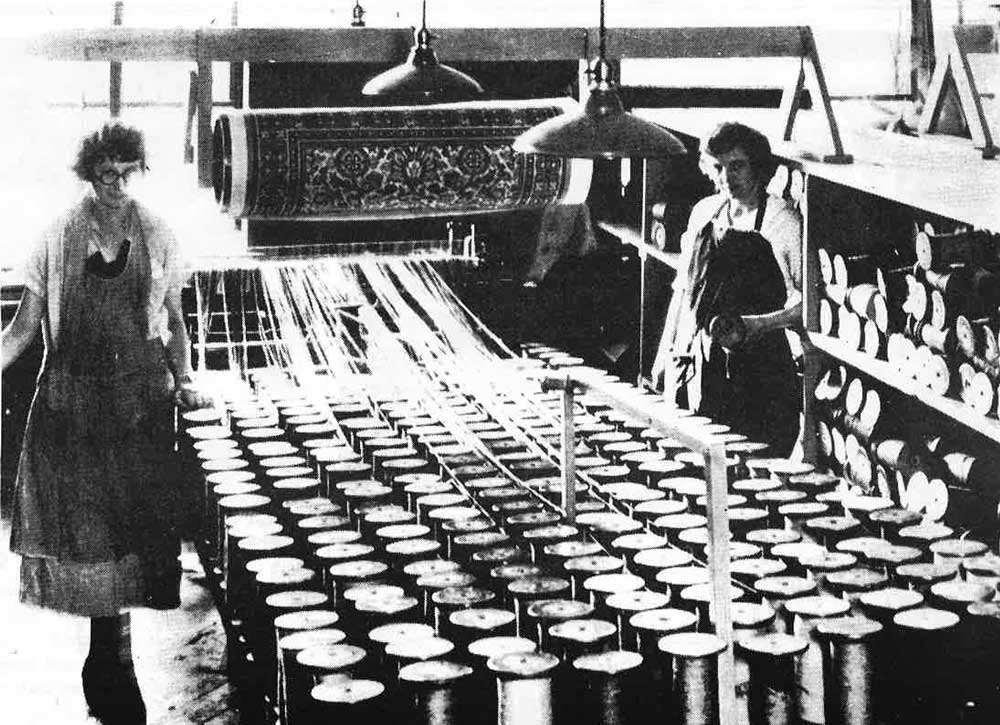
The spool room in the rug mill.
How The Rug Mill Came To Be
Now for some history of the Hightstown Smyrna Rug Company. Hightstown was an agricultural town from its earliest years to the mid-1800s: the railroad era. Once the Camden & Amboy railroad came through in the 1830s and even more so after the Hight¬stown-Pemberton railroad (the U.T.) in the 1860s, Hightstown became a center of commerce. Stores, hotels, taverns, blacksmiths, carriage makers, doctors, lawyers, and some small manufacturers were located here. But in the 1890s, many of the local merchants became concerned that Hightstown had no industry. There was a shirt company and a shoe company, as well as various milliners (hat makers) and dressmakers, but these were for mostly local purchase. No real production for the larger world. The local business people prosper when the residents make more money so the local businessmen began a search for a manufacturer to move to Hightstown. They raised money to put ads in New York and Philadelphia area newspapers.
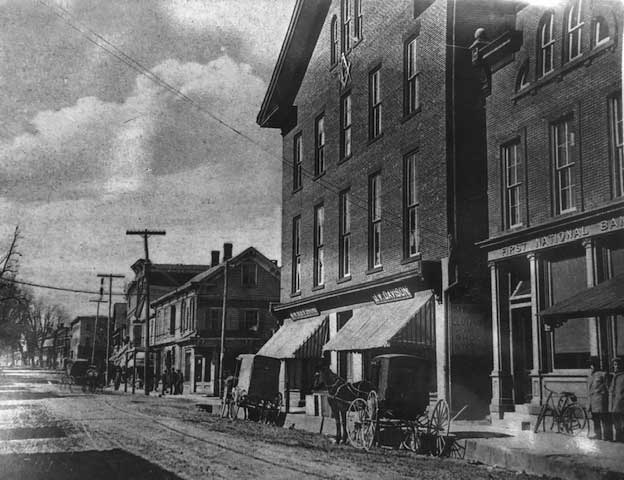
J.V. Davison Store – Brick building on the corner of Main & Stockton.
Joseph V. Davison To The Rescue
In 1898, one of the most successful businesses was the Corner Brick Store on the corner of Stockton and Main Streets, owned and operated by Joseph V. Davison. Mr. Davison had moved to Hightstown with his family in 1886 and had soon become active in local commerce issues. He must have been very respected because he was made Secretary of The Board of Trade not many years after coming to town. His store was mostly dry goods but later he expanded into produce and larger items by order, taking over many other small businesses in town.
Mr. Davison was familiar with a man named Joseph Cooke, an Englishman who had established a rug factory in a small town outside of Vineland, NJ. He was having trouble finding adequate staffing in that small town and had difficulty raising capital. Sometime in April 1898, Mr. Davison enticed Mr. Cooke to visit Hightstown and meet with the Factory Committee of the Board of Trade. After this meeting it was publicly reported in the May 5, 1898 issue of the Hightstown Gazette, “The Factory committee reports that Smyrna rug factory prospects are bright. Joseph Cooke of Vineland proposes to bring his factory here and it is believed the arrangements can be made. He asks free rent for five years and wants Hightstown to take $4,000 worth of stock. His factory is now in Janvier and employs 30 hands.” By July 14th it was reported that the Hightstown Smyrna Rug Company will be incorporated in a few days. The equipment was on its way to Hightstown and many Smyrna Company employees from Vine¬land were seen in town looking for houses.
Expansion Happens and Happens Fast
By the beginning of 1899, it was reported that the Rug Company had more orders than it could fill. It had taken over space previously occupied by a sash and blind factory. A local man, William T. Smock, was the company’s first president but he soon was replaced by one of Cooke’s men, Frank C. Moody. Late in 1899, the rug company took over the planing mill (lumber finishing mill) on the corner of Ward and Mercer Streets. The company soon occupied six buildings in this location and employed over a hundred people. Things were moving fast and furious by 1900.
But in 1901 there began some bickering between the townspeople and the factory owner. Landlords and merchants had begun raising rents and prices; a reaction to the limited supply and pros¬pering town. Others began to build houses for sale or tenancy on speculation. A rumor started to spread that the Cookes were going to move the factory out of town due to the increasing costs. One such rumor was in a Letter to the Editor on January 31, 1901, from councilman Samuel Fryer (Fryer was the owner of what is now Duryea Memorials on Mercer Street and he was the father of the man who would become the town’s only Medal of Honor winner, Eli Thompson Fryer). On February 7, 1901, Joseph Cooke vociferously denied the allegations, but Cooke acknowledged that the town needed a greater population of able workers many of whom needed to move to Hightstown from the city and they also needed affordable housing. He said that in time, rents will naturally increase but there needs to be patience. Cooke wrote, “The rug plant is a child, as it were, learning to walk. Do not put impediments in its way; and when it can walk it will bring lasting prosperity to the town. I say to Brother Fryer, let us work together for the good of all concerned.”
In July 1901, it was reported that the factory received an order for 1,000 prayer rugs to export to Egypt. In August they took over the Hightstown Shoe Company, in the Mercer Street building now occupied by Stitches-n-Ink (Babcock), and previously by Old Hights Print Shop. At that time the Company had 145 employees and had signed five-year leases with the town and landlords. Said leases did not expire until 1903. They were staying.
In January 1902, the Gazette reports that the Board of Trade was reestablished with many committees. Over thirty were involved, most with names familiar to most of us: Blauvelt, McCreery, Franklin, Skillman, Eldridge, Wear, Hutchinson, Allen, Wilbur, Dey, Mason, Chamberlin, Cooke, Kirby, Stults, Measuroll, For¬man, Titus, Norton, Scheible, Thorburn, Swetland, Cunningham, Moody, Davison, Thomas, Wilson, Rue, Plummer, Applegate, Barr, Robbins and Revs Eaches and Neal on the arbitration com¬mittee. The main focus was to work to keep the factory in town and to increase the amount of housing available. Business was still booming.
The Move To Bank Street
In February 1902, it was reported that “over 200 miles of rugs” had been manufactured. They had 129 looms and 166 employees. Talk began that the company needed a new building. In April it was revealed that the company wanted to buy the borough “gravel lot” on Bank Street, west of Rocky Brook. The council approved selling the lot to them for $25. It had cost the borough $100 a few years prior. This was a move to keep the factory in town. Its location was perfect due to the need for water for the dye works.
During the week of April 17, 1902, the Board of Trade passed a resolution and formed a committee to determine how to raise or borrow $10,000, the cost of building the new factory. The interest rate was expected to be 3.5%. J.V. Davison was one of the committee members. The loan would be guaranteed by 30 businesses in town, which would be secured by mortgages and stock in the company. Smyrna was to make annual payments of $1,000. Concurrently with these actions, Arthur Thompson, a brother of W.H. Thompson and nephew of Joseph Cooke, arrived from England and was employed by the factory. By August 1902, the negotiations, financing, and site searches were still in process. A five percent return a year was promised to the investors. At the end of the month, the directors of the Building & Loan Association held a special meeting about lending money for the construction of the factory. It was decided to increase the stock offering and Allen & Stults was instructed to secure the subscriptions. They reported that 175 new shares had been subscribed. Individuals loaned $12,000 for the factory. They were J.V. Davison, Wm. Robbins, D.H. Cun¬ningham, Dr. Titus, Thomas Mason, Wilson Bros, D.B. Dey, E.H Savige, MP Chamberlin, A.T. Skillman, Dr. Franklin, Dr. Wilbur, Allen & Stults, C.C. Blauvelt, J.G Scheible, D.W. Measuroll, R.A. Outcalt, W.F. Dillatush and Samuel Fryer. The Building & Loan would loan the balance. By September the Building & Loan had sold 275 new shares.
The new company had to expand or move and additional financing had to be arranged. The businessmen in town and the Building & Loan arranged for the financing and the Borough agreed to sell the land, which had been a dump, to the company. The lot was procured and the financing arranged. The Rug Factory was to stay in Hightstown in a new building of its own on Bank Street. It was brick, three stories with a basement, as it is today. It was occupied in February 1903, about the same time that the five-year leases on Mercer Street were to expire. Some operations remained on Ward Street until 1905. But trouble “loomed” for the factory. The popularity of Smyrna rugs was shrinking as Axminster rugs were taking hold in the market. The latter being more attractive and lower in price. The market also wanted larger rugs, where the local factory looms were mostly for runners and smaller rugs. Axminster rugs were larger, 9 or even 12 feet wide.
After having their new building, Cooke purchased all new power looms up to 12 feet in width but they were still making Smyrna, not Axminster rugs. Sales continued to drop. When the financial panic hit in 1907, Cooke found that he could not continue.
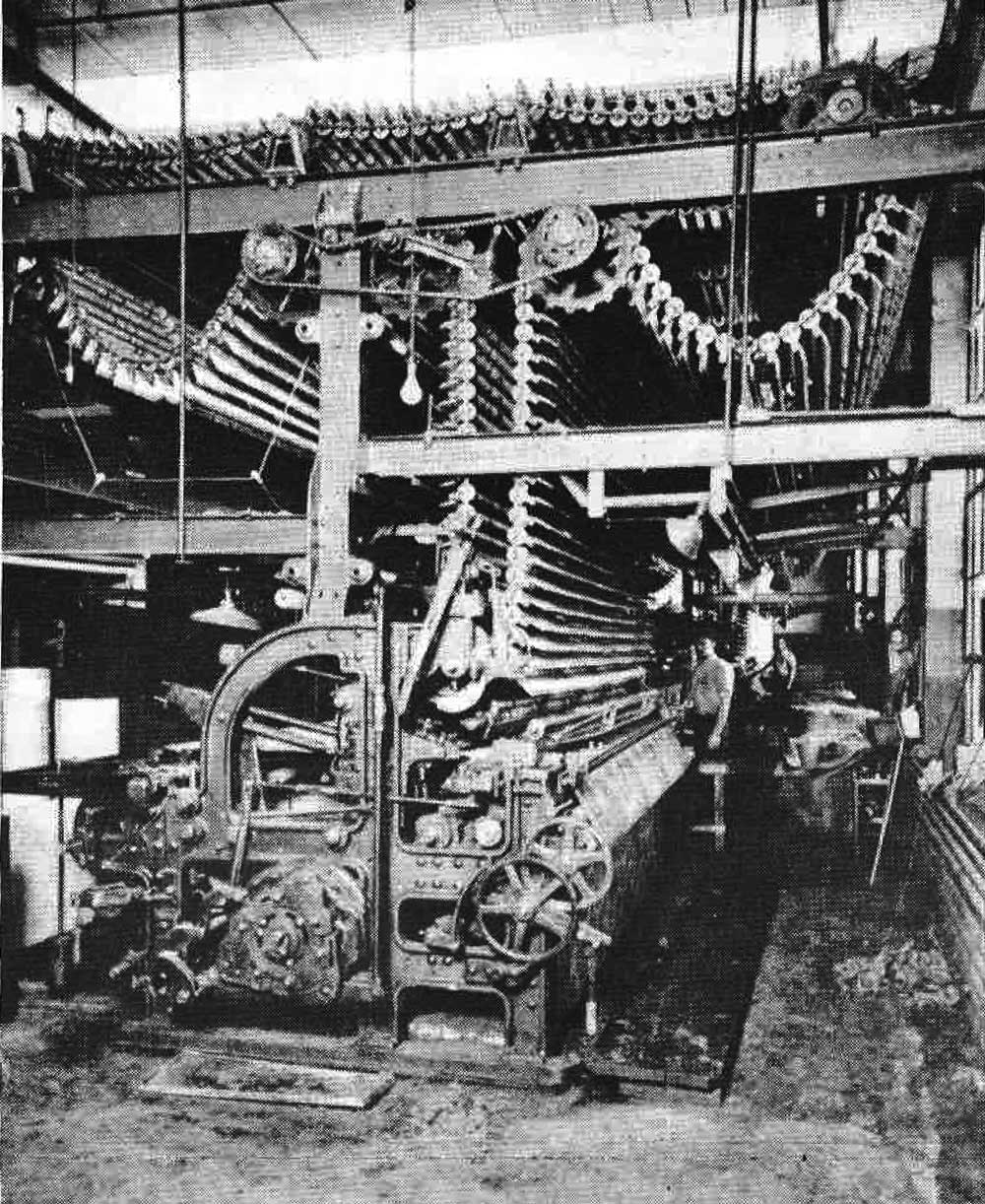
Large twelve foot looms
Keeping the Company Going
J.V. Davison’s son, C. Herbert Davison, came into the company doing chores, the payrolls, learned about yarn and the winders, dyeing, and what all the departments did while his father, J.V. Davison, was traveling the country selling rugs. By 1910 it became apparent that they could not make money continuing to make Smyrna rugs and it was decided that the senior Davison would go to Chicago and sell everything in stock and in process at whatever price could be had. Upon his return, the debts would be paid and the business would be closed down. Cooke was gone from the company, but his nephew Thomp¬son remained with the company. Herbert Davison (senior) writes in his company history, “Father was gone several weeks and by the time he had returned was using the top floor of the mill to manufacture canvas gloves, pounding out with a mallet and hand dyes the raw material for the gloves and having them sewed up at private homes.” They did anything to pay the bills and keep the company open.
He continues, “When father came home we sat down for a conference and discussed the whole situation. He had sold the merchandise we then had and would be able to make, and at a price that would enable him to pay all debts and have approximately the original investment of $15,000 leftover, plus of course, the mill and the machinery, most of which was obsolete.” The younger Davison and Thompson asked J.V. if there was no way to keep the operation going. J.V. indicated that only if the factory was changed to manufacture Axminsters versus Smyrna could it survive. They called Crompton & Knowles Loom Works and were told it would cost more than $15,000. They only had $15,000 on hand. Plus they still owed the Building & Loan.
They were able to convince Crompton & Knowles to lease them five looms for five years and the Building & Loan agreed to renew the loan. Within six months they were back in operation. They did well. The WWI years brought another panic and the older Davison told his son he wanted out and he wanted $150,000 for the business to be paid in five years. The young¬er Davison and Thompson agreed to the demand and went in 50-50. The European war years brought skyrocketing prices for Axminster rugs which were great for those made in Hightstown. In the Spring of 1918, they were able to pay off the notes to the Building & Loan and J.V. Davison ahead of schedule.
The income tax was new in 1918 and they did not understand the tax ramifications of what they had done using accumulated earnings over four years to pay off J.V. This was not an uncommon error for many businesses at that time. This cost them $50,000 in income taxes. Through hard work and great sales, they paid off the IRS in less than a year.
Early in this article, I wrote about Corner Brick Store – J.V. Davisons. This was still owned by C Herbert Davison’s brothers but the brothers, Joe and Howard, did not get along. In 1912 Howard took the grocery business and moved it to “Fountain Square” (the point of South Main and Mercer Streets). Joe continued to run the dry goods business. Howard’s business closed in 1917 and Joe’s closed in 1925. How¬ard went into the shoe manufacturing business with Dr. George Franklin’s son Will. This failed too and Howard was hired by his brother Herbert in 1919.
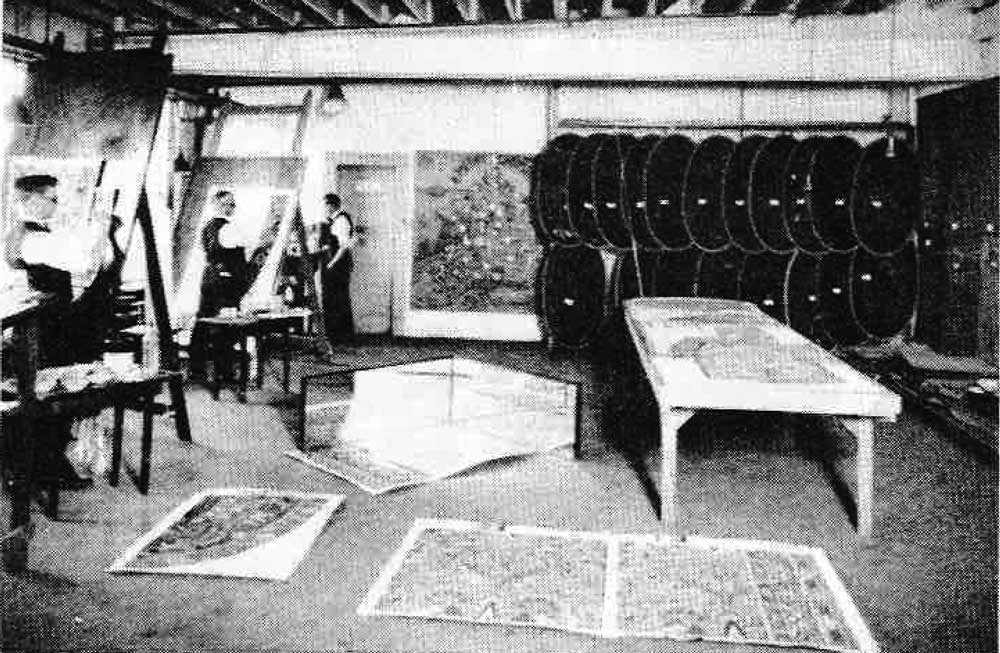
Design room.
Problems Arise
During the WWI years, Herbert Davison traveled extensively selling the rugs. William H. Thompson took over the finances and mill management. In Davison’s written rug mill history, he wrote that Thompson intentionally kept him in the dark on many issues. Davison did not even have a desk in the mill due to his traveling. One year when Thompson went to England for six to eight weeks, Davison took over the daily operations. He writes that he did not find any misappropriations or irregularities, but he did find that Thompson had brought in many family members at excessive salaries without Davison’s approval. Specifically, he mentions Arthur, Reginald, Ernest, and Homer Thompson as well as Thompson’s sons-in-law and his wife’s brother. Upon Thomp¬son’s return, Davison told him this had to stop and it did. After the war in 1922, the company name was changed to Hightstown Rug Company.
In 1927 things hit the fan between Davi¬son and Thompson and a buy-sell agreement was to be signed in 1928. Within the 90-day option period, Thompson had sold the entire mill to a New York holding company. This appears to have been somewhat of a scam as they had no money but attempted to float a bond issue for $1,750,000. It was subscribed within three months so the reputation of the company was still attractive to investors. The Hightstown Rug Company received $.88 on the dollar and the NY holding company bled $400,000 of cash out of the company. Thompson was to receive $2,750,000 and pay Davison $1,300,000 out of that amount. The investment company then came to Davison saying they would not pay the money and wanted him to loan them $1,300,000 which he agreed to do in order to save the company.
After several miscues and bad decisions, the crash of 1929 actually helped Davison as the investment company filed for bankruptcy. Davison got paid his notes, the common stock, and half of the preferred stock after a lawsuit but he had to put two members of the investment company on the board. But the bottom line is that Davison got the Ruggie back. His son, Herbert B. Davison, joined the business in 1933. He held many positions but I remember “Uncle Herbie” spending much of his time on the road selling rugs, just like his father and grandfather had. He was a very likable, gracious, and generous man and in later years a strong contributor to the Historical Society. During WWII the factory was converted to make parachutes for the war effort. After the war, it converted back but due to competition from the South, the “Ruggie” was sold in the 1960s to United Industrial Syndicate who later sold it to Kentile Floors. All of the operations had moved to their East Windsor plant by then (now Shiseido on Hightstown Princeton Road).
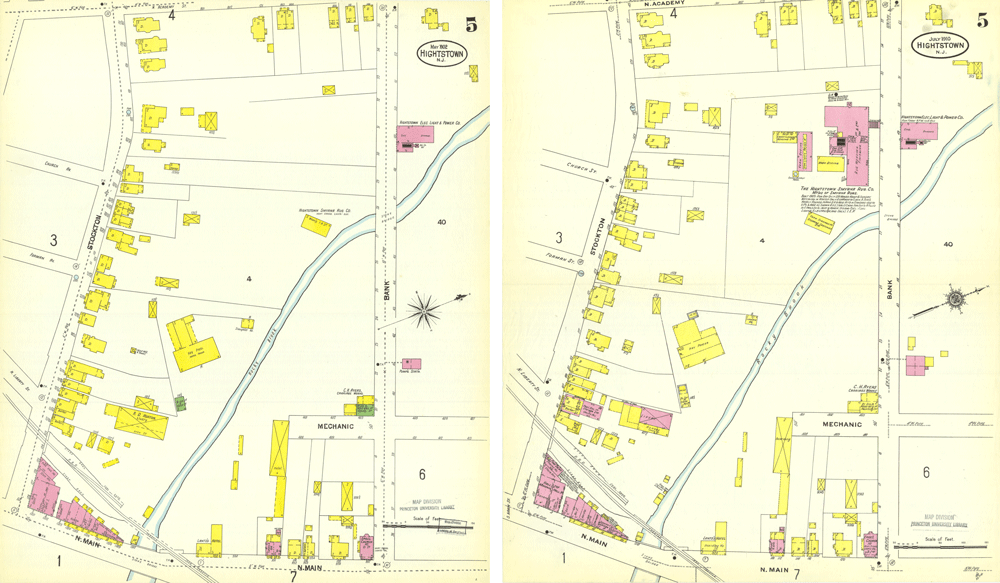
Sanborn Company Map – New York, NY (Left: 1902, Right: 1910) – 1910 map shows the rug mill while the 1902 maps doesn’t.
These maps are from the Sanborn Map Company. They published maps in the late 19th and 20th centuries that were primarily used by fire insurance companies to determine values, premium rates and the insurance company’s total risk in certain areas. Different colors meant a type of construction. The Society and Allen & Stults Co. have maps from 1895 through the 1950s.
More Change Comes to The Mill
As for the Bank Street property, in the 1960s, and early 1970s, McGraw Hill rented the eastern building as they needed more office space (I was a “mail boy” for McGraw Hill in summers 1969-1971 and delivered mail there). Eventually, the building was purchased by North American Phillips Lighting. After they left in the late 1980s, the building has had a few other owners but has been mostly vacant for many years during this period. We look forward to the preservation and adaptive reuse of this brick factory building that has been so important to the history of Hight¬stown.
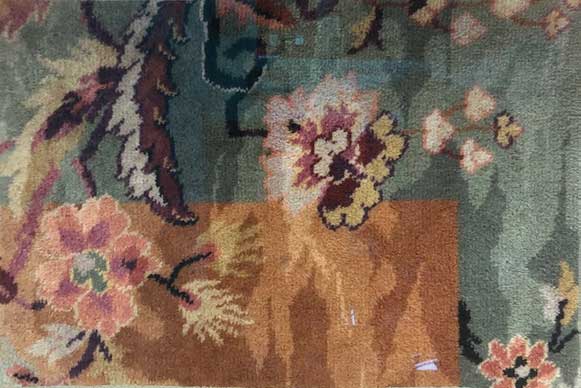
Axminster rug found in California made in Hightstown in 2017
This rug was recovered in Chester County, California, by a California resident, Christine Fagan, in November 2016. She researched the Hightstown Rug Company, contacted the Society and arranged for the rugs shipping to Hightstown. A newfound friend from across the country. We thank Christine for her care and consideration.
Support local history like this by becoming a member here.
